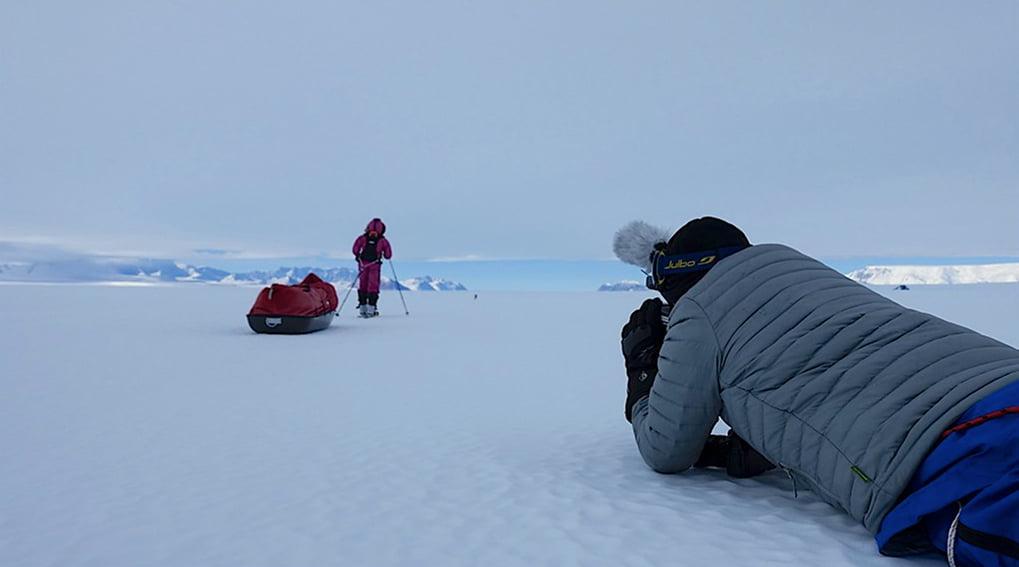Although I have done several expeditions to the North and South Poles, both as an independent traveler and as a guide, each new trip brings new gear ideas. There are also old, tried-and-true patterns that I have used for years. As I begin the season at the South Pole, let’s take a look at my gear. Today: electronics.
One note: Proper gear is only one aspect of polar travel. Developing skills, planning and logistics, understanding the polar environment, and knowing how to minimize risk are equally important. If you want to accelerate your progress as a polar traveler, consider hiring an IPGA guide.
Batteries
There are two types of batteries recommended for use in cold climates: Lithium Ion (Li-Ion) and Lithium Polymer (Li-Po). Both are high density, which means a lot of power in a relatively small package.
Li-Ion batteries use a liquid electrolyte and can easily leak and catch fire. On the other hand, they have less memory loss and are cheaper (and easier to use) than Li-Po.
Li-Po batteries use a gel electrolyte so are less prone to leakage and can be manufactured in multiple profiles. But it is more expensive and has a shorter life.
Depending on the duration of your trip and how power hungry you are, you either recharge your power banks with solar or wind (I’ll chat about this later) or take multiple power banks. In 2011, I led a team from the North Pole to Canada, and we uploaded one minute of footage almost every day for 40 days via MacBook and Iridium modem. From memory, we brought 10 HyperJuice batteries (18v ) because it was too early in the season for effective solar charging.
Check the specs of the power bank before buying, as some deliver less than 80% of their stated power.

Anker 10,000mAh wireless powerbank, Silicon Power 20,000mAh powerbank, InCharge charging cables, lithium AA batteries. Photo: Eric Philips
Things to consider:
- 20,000mAh is a good compromise between weight and capacity
- USB-C offers faster charging
- Dual output ports charge two things at once
- Pass-through charging (charge the power bank while charging your device)
- A backup wireless power bank, if your phone supports it
- Use only quality braided cables; Multi-heads can be comfortable
- Protect the batteries from moisture. I once destroyed a power bank that was knocked over by a kettle in the tent.
- Use only lithium AA and AAA
Heating batteries
Although electronics tolerate cold better than heat and lithium (currently) is best for polar use, any battery will be better once warmed.
For years, I used a Lumix DMC-FT6 camera because somehow, the battery worked at -40°C. No idea how. The optics are average but the magic battery allows me to take pictures even on very cold days. Now I want better optics, and I have a system for taking pictures that works for me. I put the battery of my Sony RX-100 in a pocket of my shell pants and slide it into the camera when I want a photo. It seems to be sufficient to operate in all temperatures.
Taking photos with a phone is common, but the danger to fingers in extreme cold is obvious. Phone batteries (Li-Ion) are improving all the time, but you need them warm if you want to use them during the day.

A collection of charging devices. Photo: Eric Philips
There is generally no need to heat up your power bank while you are traveling although it can accept solar charge more efficiently. Drone batteries are usually the most in demand. Keeping them next to a Nalgene filled with boiling water until you need them is a good option. Alternatively, keep it in an inside pocket, even though that can be awkward. Chemical hand warmers don’t seem to work very well for this purpose.
A power bank delivers a charge in most temperatures but does so more consistently when warm. In Antarctica, you probably have enough solar radiation in the tent to heat the battery. If you need extra energy, use the hot bottle trick or hang the battery in a bag from the ceiling, preferably not over the stove!

Frederique Olivier prepares his drone while filming our expedition in Svalbard, April 2022. Photo: Eric Philips
For best overnight charging, sleep with your power bank while it charges your devices unless it is solar charged. That’s where it’s useful to have two banks and change them every night. I put my phone under my pillow while charging overnight, using vibrate as my alarm.
